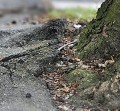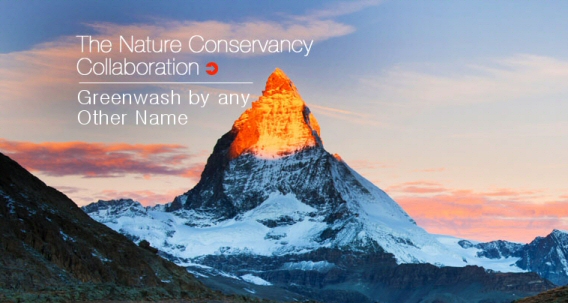Nature Conservancy Embrace Dow Chemical Business Model
Posted by keith on January 27th, 2011
Below is a long list of chemical compounds and elements. This is not just an ordinary list, for it is special in all sorts of ways – not least of all to anyone who is a supporter of our old friends The Nature Conservancy. The list contains just those substances that the US Environmental Protection Agency deem it necessary for companies to declare, and which have been declared by one particular company, for just one site:
1,1,1,2-TETRACHLOROETHANE
1,1,1-TRICHLOROETHANE
1,1,2,2-TETRACHLOROETHANE
1,1,2-TRICHLOROETHANE
1,2,3-TRICHLOROPROPANE
1,2,4-TRIMETHYLBENZENE
1,2-DICHLOROBENZENE
1,2-DICHLOROETHANE
1,2-DICHLOROETHYLENE
1,2-DICHLOROPROPANE
1,3-BUTADIENE
1,3-DICHLOROBENZENE
1,3-DICHLOROPROPYLENE
1,4-DIOXANE
2,2-DICHLORO-1,1,1-TRIFLUOROETHANE
2,3-DICHLOROPROPENE
ACETALDEHYDE
ACRYLAMIDE
ALLYL ALCOHOL
ALLYL CHLORIDE
ALUMINUM (FUME OR DUST)
AMMONIA
ANTHRACENE
ANTIMONY
ARSENIC
ASBESTOS (FRIABLE)
BARIUM COMPOUNDS
BENZENE
BERYLLIUM
BIPHENYL
BIS(2-CHLORO-1-METHYLETHYL) ETHER
BROMOFORM
BROMOMETHANE
CADMIUM
CARBON DISULFIDE
CARBON TETRACHLORIDE
CERTAIN GLYCOL ETHERS
CHLORINE
CHLOROBENZENE
CHLORODIFLUOROMETHANE
CHLOROETHANE
CHLOROFORM
CHLOROMETHANE
CHROMIUM
COBALT COMPOUNDS
COPPER COMPOUNDS
CUMENE
CYCLOHEXANE
DIBENZOFURAN
DICHLOROBROMOMETHANE
DICHLOROMETHANE
DICHLOROTRIFLUOROETHANE
DICYCLOPENTADIENE
DIOXIN AND DIOXIN-LIKE COMPOUNDS
EPICHLOROHYDRIN
ETHYLBENZENE
ETHYLENE
ETHYLENE GLYCOL
ETHYLENE OXIDE
ETHYLIDENE DICHLORIDE
FORMALDEHYDE
FORMIC ACID
HEXACHLORO-1,3-BUTADIENE
HEXACHLOROBENZENE
HEXACHLOROETHANE
HYDROCHLORIC ACID (1995 AND AFTER 'ACID AEROSOLS' ONLY)
LEAD
MANGANESE
MERCURY
METHANOL
METHYL ISOBUTYL KETONE
N-BUTYL ALCOHOL
N-HEXANE
NAPHTHALENE
NICKEL COMPOUNDS
NITRATE COMPOUNDS
NITRIC ACID
PENTACHLOROBENZENE
PENTACHLOROETHANE
PHENANTHRENE
POLYCYCLIC AROMATIC COMPOUNDS
PROPIONALDEHYDE
PROPYLENE
PROPYLENE OXIDE
PYRIDINE
SELENIUM
SILVER COMPOUNDS
STYRENE
SULFURIC ACID (1994 AND AFTER 'ACID AEROSOLS' ONLY)
TETRACHLOROETHYLENE
THALLIUM
TOLUENE
TRICHLOROETHYLENE
VANADIUM (EXCEPT WHEN CONTAINED IN AN ALLOY)
VINYL CHLORIDE
VINYLIDENE CHLORIDE
XYLENE (MIXED ISOMERS)
ZINC COMPOUNDS
But not only is this a list of substances merely declared, it is a list of substances that have been released into the environment beyond the legal boundaries of the site: The Dow Chemical plant, Plaquemine, Louisiana. Every one of these substances is classified as a pollutant by the EPA; every one of these substances is out of the control of Dow Chemical.
This list is not from 1940, or even 1970, but 2009. In 2009, this one plant released half a ton of lead; a pound of dioxin; 12 tons of benzene; 32 pounds of mercury…go and look for yourself if you want. It’s all in a handily downloadable file.
This is just one site, albeit a big one, from the EPA list, which only covers the USA. According to Dow Chemical themselves, “China is Dow’s second largest country in terms of sales, with 5 business centers, 20 manufacturing sites and approximately 3,900 employees.” That’s one more nation: 20 more sites, none of which are under such close scrutiny as in the USA.
The nature of Dow Chemical is the manufacturing and processing of industrial products. This is a good snapshot of the corporation:
The Dow Chemical Company is the world’s second largest chemical company, behind only BASF. Dow’s primary industries are chemicals, herbicides, pesticides, agricultural sciences and plastics. Dow’s main business is supplying chemicals to other industrial and chemical companies. Using oil, coals, natural gas, salt, brine and other basic inputs, Dow makes inorganic chemicals like soda, solvents, and chlorine, and organic chemicals like acetone, ethylene glycol, glycerine, phenols, etc. Dow is also the biggest plastics manufacturer in the world.
The page from which this comes is required reading for anyone who wants to absorb (and, no doubt, your body already has) the nature of Dow’s business. Like any corporation, they exist to make money for their shareholders – and like any corporation, if they can get away with something to increase shareholder profit then they will. It’s the nature of capitalism; the name of the game.
If you visit Dow’s website, then you will notice something truly striking: a bloody great mountain; a pristine lake; desert sands and an ocean full of tropical fish. That thing about getting away with something – Dow have mastered the art. While few people will ever read the EPA reports on Dow’s toxic releases, many people will go to Dow’s website and be confronted with a tableau of nature’s bounty, and the following words:
The Nature Conservancy Collaboration
Leaping in head first to the challenge of “protecting nature” in partnership with Dow chemical is The Nature Conservancy, which Dow have kindly furnished with $10 million over a five year period.
According to TNC: “The Nature Conservancy and Dow Chemical Company are working together on a breakthrough collaboration to demonstrate that protecting nature can be a global business strategy – and a corporate priority. Dow and its foundation together have committed $10 million over the next five years to develop tools and demonstrate models for valuing nature in business decisions. With the help of the Conservancy, Dow will work to incorporate biodiversity and the value of nature into its company-wide goals, strategies and objectives. With support from Dow’s foundation, the Conservancy will use lessons learned, collaborative scientific analyses, and its own conservation experience to pursue wide-spread use of these conservation tools by other companies.”
$10 million may seem like a lot of money to you and me, but to Dow Chemical it’s just 0.3% of their annual profit (as of 2009) – yes, that’s profit, not income, which is 3 times as much. Actually it’s even less because Dow can claw much of that investment back in charitable giving rebates. And what do Dow Chemical get for that $2 million a year?
They get branding – everywhere, on their websites, on the Nature Conservancy’s website, on their corporate materials (The Nature Conservancy logo), on every billboard and TV ad they are no doubt planning to roll out in order to make the most of their “partnership”.
They get fantastic PR – just do a quick search on “Dow Chemical” and “Nature Conservancy” and as of today there are 115,000 hits on Google. More specifically, do a search for “Dow Chemical” and “protecting the earth” and you get 2,590 results and counting. Dow look like a great, green company.
They make money – just look at the wording of the joint press release from Dow and TNC:
MIDLAND, MICHIGAN – January 24, 2011 – Andrew Liveris, chairman and chief executive officer of The Dow Chemical Company (NYSE: DOW) and Mark Tercek, chief executive officer of The Nature Conservancy jointly announced today a new collaboration between the organizations to help Dow and other companies recognize, value and incorporate nature into global business goals, decisions and strategies. The senior leaders issued the news to some of the world’s foremost business, environmental and sustainability leaders, dignitaries and media at the Detroit Economic Club.
The global organizations will work together to apply scientific knowledge and experience to examine how Dow’s operations rely on and affect nature. The aim of the collaboration is to advance the incorporation of the value of nature into business, and to take action to protect the earth’s natural systems and the services they provide people, for the benefit of business and society. One of the major objectives of this collaboration is to share all tools, lessons learned and results publicly and through peer-review so that other companies, scientists and interested parties can test and apply them.
“This collaboration is designed to help us innovate new approaches to critical world challenges while demonstrating that environmental conservation is not just good for nature – it is good for business,” Liveris said. “Companies that value and integrate biodiversity and ecosystem services into their strategic plans are best positioned for the future by operationalizing sustainability. At Dow, we see sustainability as an adjective and one that we apply to almost everything we do: sustainable manufacturing, sustainable solutions and sustainable opportunities to constantly add to the quality of life for our communities and fellow citizens. Today, tomorrow, always.”
What a crock of shit! I have emphasised the parts that betray the true reason for the deal because they have so carefully been wrapped in a shawl of greewash, ably assisted by one of the largest NGOs in the world. Dow Chemical have hamstrung not only the business-friendly Nature Conservancy, but anyone who really believes that business can work in partnership with nature.
The whole concept of “nature” as an entity is alien to the business world except as a resource to be exploited for profit; the PR copy version of “Nature” might benefit – hey, want to see a pristine lake protected by Dow’s money? – but look beyond that lake, into the soil, the underground water supplies, up into the air, down through the oceans and weaving our way through the organic tapestry of life that is being picked apart, terminally frayed by the activities of the industrial world. Look beyond the glowing, rhetoric laden bullshit touted by companies like Dow, dutifully spewed out by dangerous NGOs like The Nature Conservancy, and you see something that should never have been.
A ruined world: Today, tomorrow, always.
Or at least until the industrial system is gone.






January 27th, 2011 at 7:19 am
Truly appalling. I wonder who has a map of Dow with “surveyor marks” on their various sites. I wonder how one may help take down this kind of dissembling rapine.
BTW, you might add to your long reading list a short, extremely informative book, “Climate Cover-Up” by James Hoggan and Richard Littlemore. Hoggan is a PR pro from way back and sees through the systematic campaign to lie, mislead people, minimize reality, and otherwise obscure the impact of industrial humanity on the planet, specifically global heating. It’s a special case of greenwashing, but the tools and insights are transferrable.
A longer, equally informative book is “The End of the Long Summer” by Dianne Dumanoski. The analysis of the system’s dysfunction and proposals for change are arresting.
Fight on. You are not alone.
January 27th, 2011 at 10:50 pm
So, for years Dow and companies like it, have been subjected to regulation, or what passes for it in the U.S., developing nations and elsewhere. Still, the company is harming the environment and making money. So, the Conservancy comes along and says, “Well, since things are as they are, how can we make it better?” They reach to the company and say, “Let’s try something new.” Dow, amazingly, says, “OK.”
So, we can have the same ol’, same ol’ status quo…regulation that isn’t changing anything…or try something new. I think we should give the Conservancy some benefit of the doubt. The organization is loaded with top-notch scientists. You think they all are in cahoots with Big Business to greenwash? Or, maybe…just maybe…they are on to something. Maybe they can make things better. Maybe they can show Dow there’s another way. Maybe what works with Dow can influence other companies. On the other hand…maybe not.
According to the press release you cited they are going to seek to publish in peer reviewed journals papers based on what they learn. Seems pretty transparent.
The Conservancy does good work all over the place. Let’s see what this “collaboration” results in. If, at the end of the five years, there’s no published papers, no measurable change in Dow practices and nature is no better off, let’s all stand up and call them greenwashers. Until then, let’s watch them closely, read those papers they promise are coming and see if nature is better off as a result of this project.
I’m willing to bet that the people working on this project for the Conservancy will do more for the environment through this project than any other of us will accomplish over the same time period.
January 28th, 2011 at 4:14 am
Hi Kelly, I don’t think you quite got the implication of what I am saying – you have just addressed the superficial question of whether TNC can improve Dow Chemical’s performance. And, yes, I suppose in a few small areas maybe they can – on the other hand, Dow get a huge amount of free advertising and great PR out of this. $2m a year won’t buy anything substantial in the advertising mainstream; just look what it has bought Dow! If Dow can position TNC in just the right place then they can avoid too much government and, more importantly, public scrutiny. People will look at Dow and think: “Aren’t they a good company, they can’t possibly be doing anything wrong because the Nature Conservancy are keeping an eye on them.”
This is, of course, exactly what Dow’s investment aims to achieve. Yes, it is an INVESTMENT – not in the natural environment, but in Dow’s corporate future. Your response has just shown how effective this move already is. We don’t have another 5 years to see whether corporations continue to screw the planet into an abyss: they will do, and TNC are just making it easier for them to do so.
Keith
P.S. I would have thought overall opposition to corporate activities was a more useful measure than business as usual with a green tinge. The Unsuitablog, among others, has made greenwashing much more difficult – I see that as a greater achievement than Corporate Social Responsibility (what a brilliant misnomer that is).
January 28th, 2011 at 4:17 am
As usual Keith I am delighted by the way you lay out this information and so clearly show how totally compromised organisations like The Nature Conservancy are.
It’s sad to see, but just demonstrates yet again that there is no “solution” (let alone an easy one), other than drastically changing how we live in our world.
I may have mentioned in a previous comment that my family have recently taken over an old (100 years) wood fired bakery. I now bake “the town’s” bread each morning. It’s hard and honest work that really puts the world of unstoppable consumption in perspective.
LS
January 28th, 2011 at 9:31 am
[…] Below is a long list of chemical compounds and elements. This is not just an ordinary list, for it is special in all sorts of ways – not least of all to anyone who is a supporter of our old friends The Nature Conservancy (the often Greenwash of the Week winner). The list contains just those substances that the US Environmental Protection Agency deem it necessary for companies to declare, and which have been declared by one particular company, for just one site. But not only is this a list of substances merely declared, it is a list of substances that have been released into the environment beyond the legal boundaries of the site: The Dow Chemical plant, Plaquemine, Louisiana. […]
January 28th, 2011 at 6:32 pm
To further Keith’s perspective on this, it must be made apparent that is isn’t an aberration on the part of The Nature Conservancy – this is how they operate these days, and have for some time. I’ve been in rooms with them for countless hours as they helped to plan areas for timber sales on the Tongass National Forest in Alaska – which is only the worlds largest remaining temperate rainforest, and already riddled with systemic ecological problems from 100+ years of clearcutting on federal, state, and Native lands. It’s why Weyerhauser, Dow, BP (yes, BP) and many other corporations are on the Conservancy’s Leadership Council.
The beat goes on.
June 24th, 2011 at 10:43 pm
Bravo for the reporting. I spent 3 months in Brazil, coming back at the time of this announcement, after just having met with TNC representatives there. What I learned was appalling. Having had respect for the organization, I went to them to see if they’d like to buy organic rainforest tree seedlings, produced by a cooperative of rural nurseries to supply the reforestation goals of Sao Paulo state, who I represent. But I learned the growers couldn’t sell to them as cheaply as the Dow subsidized TNC nursery, and the deal had already been made between Dow, TNC and the state of SP to use their trees to replant the waterways.
I later learned several former Goldman Sachs execs are the Conservancy’s top people now.
I fund the organic, fair trade, permaculture reforestation project by working with families who put on benefit concerts and bake sales, churches who give me a platform to speak, and by giving away my museum art to donors. What other way is there for real people to support real people?
August 23rd, 2011 at 7:19 pm
Look up the name Thmas Middleton who sits on the board of nature conservancy. He is also senior managing director of the Blackstone Group, which currently owns Nalco (the makers of corexit). Blackstone Group will be selling Nalco to EcoLab Inc. which sits on the international leadership council of nature conservancy. Nice cozy relationship with the makers of corexit and nature conservancy. No wonder they stated silent when all of that poison was being dumped into the Gulf.